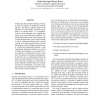2031 search results - page 73 / 407 » Non-symmetric Support Vector Machines |
ACSW
2004
13 years 9 months ago
2004
This paper describes an approach to the detection of stress in spoken New Zealand English. After identifying the vowel segments of the speech signal, the approach extracts two dif...
BIOCOMP
2006
13 years 9 months ago
2006
- microRNAs (miRNAs) are 20-22 nt noncoding RNAs which are rapidly emerging as crucial regulators of gene expression in plants and animals. Identification of the hairpins which yie...
EMNLP
2004
13 years 9 months ago
2004
This paper introduces an approach to sentiment analysis which uses support vector machines (SVMs) to bring together diverse sources of potentially pertinent information, including...
ECIR
2003
Springer
13 years 9 months ago
2003
Springer
In order to reduce human efforts, there has been increasing interest in applying active learning for training text classifiers. This paper describes a straightforward active learni...
NAACL
2003
13 years 9 months ago
2003
In this paper, the automatic labeling of semantic roles in a sentence is considered as a chunking task. We define a semantic chunk as the sequence of words that fills a semantic...

